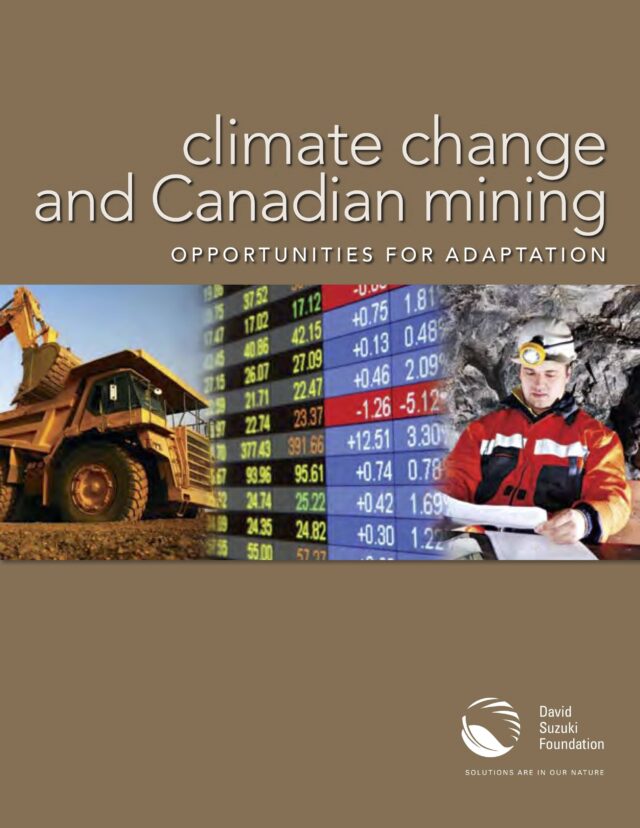Climate Change and Canadian Mining: Opportunities for Adaptation
Published by:
David Suzuki Foundation
Authored by:
Tristan Pearce,
James D. Ford,
Jason Prno,
Frank Duerden
Climate solutions industry, policy and regulation, Saskatchewan, Ontario, Quebec, Northwest Territories, Yukon, economics, climate change
Due to its dependency on the natural environment, the Canadian mining industry is particularly vulnerable to the consequences of climate change. The Canadian mining industry employs nearly 50,000 people in primary mineral extraction in over 115 communities across the country and contributes approximately $10 billion a year to the Canadian economy. Downstream activities — smelting and refining minerals, processing non-metallic mineral products, and fabrication of metal products — contribute even more.
Climate Change and Canadian Mining: Opportunities for Adaptation describes the vulnerability of the Canadian mining industry to climate change, highlights opportunities for adaptation and provides recommendations for industry and government.
Key Findings
Why the mining industry is important to Canada:
- The industry employs nearly 50,000 people in primary mineral extraction and several times that number in downstream activities.
- Mining is a national industry with operations in 115 communities across the country.
- Primary mineral extraction contributes $10 billion a year to the Canadian economy.
Examples of the mining industry’s vulnerability to climatic conditions:
- A multi-year drought in Saskatchewan in the late 1980s resulted in the Chaplin sodium sulphate mine nearly halting production due to reduced water levels.
- In 2005, a similar situation in Marathon, Ontario, resulted in several mines reducing water intake and finding alternative resources.
- Hot and dry temperatures in recent years has decreased the availability of water in southern Quebec, forcing gravel quarries to curtail production in order to abide by dust suppression regulations
- The 1998 ice storm cut off power to several mines in Quebec for three to four weeks.
- Warm winter temperatures in 2006 led to ice road closures in the NWT costing diamond mines millions of dollars for fuel and equipment to be transported by air.
- In August 2008, heavy rains in the Yukon flooded four kilometres of the Minto mine access road and forced the company to release excess untreated water directly into the Yukon River system.
- Lower water levels in the Great Lakes have necessitated smaller shipping loads of metals and non-metals; an example of an indirect climate impact on the mining sector.
How the mining industry perceives the future impacts of climate change on its operations:
- The results of two surveys indicate that between 34 and 48 per cent of mining stakeholders believe that climate change is already having a negative impact on their operations, confirming that it is an emerging issue facing the sector.
- Despite the perceived threat most companies were not proactively planning for climate change. Only 25 per cent of senior executives and those in management viewed future climate change as something that could affect their operations while all of those working in day-to-day mining operations perceived this threat.
- Surveys strongly suggest that the mining sector is taking action to reduce greenhouse gas emissions and mitigation, not adaptation, is the most common action being taken to address global warming.
- Nearly all respondents expected action to reduce greenhouse gas emissions would continue into the future.
Solutions
Opportunities exist for the mining industry to understand and adapt to a changing climate:
- More effective communication of the potential risks posed by climate change is needed in the mining sector.
- Identification of the most cost-effective measures and technologies that will allow mines to adapt to climate change. Specifically, win-win adaptations that bring benefits regardless of the severity of climate change impacts need to be identified.
- Adaptation and mitigation in many instances can reinforce each other. Research is needed to assess how this can be achieved for different mining operations and regions.
- Further research is needed on the impacts of climate change in mine rehabilitation projects as there are an estimated 27,000 orphaned or abandoned mines in Canada.
What governments can do:
- Regulations are needed to mandate that mines plan for climate change both during their operational lifespan and through decommissioning. There is an opportunity for climate change planning to be enforced in closure planning.
- Regulatory certainty in regards to greenhouse gas mitigation needs to be established before mitigation efforts truly take hold in the mining sector. Developing this certainty should be a priority.
- There is a need for improved climate modelling and communication of climate change projections to better understand the risks that might affect mine sites and regions.
- The federal government should restore research funding for climate change impacts and adaptation in this sector and others.”
